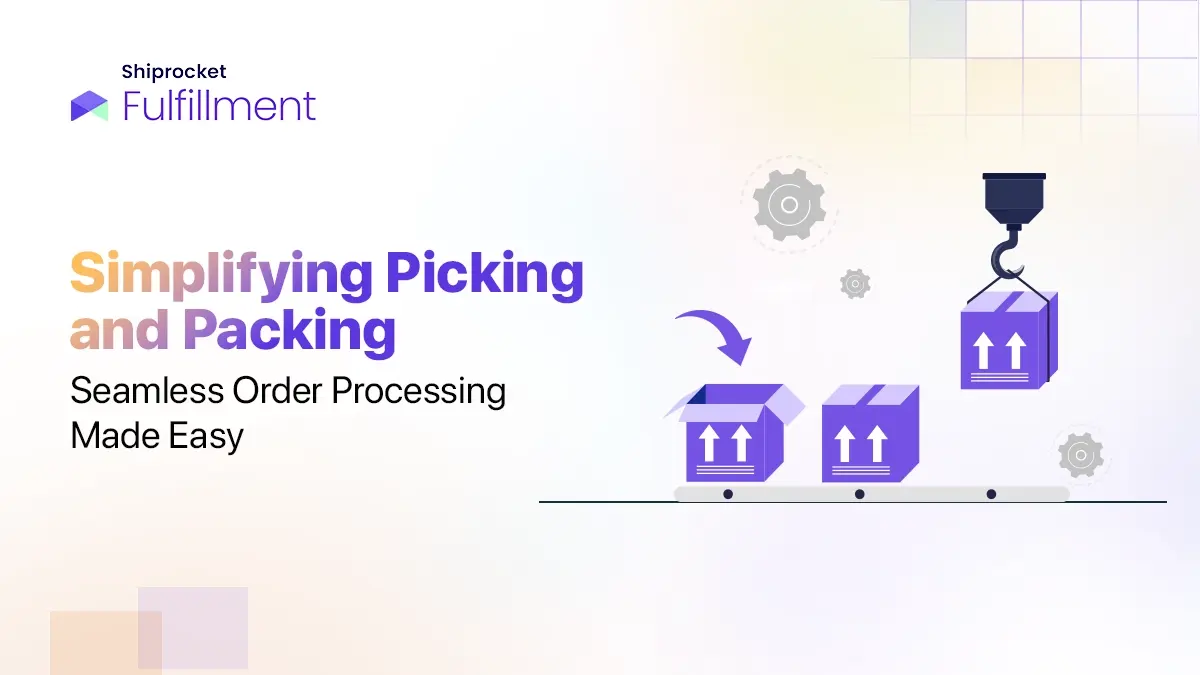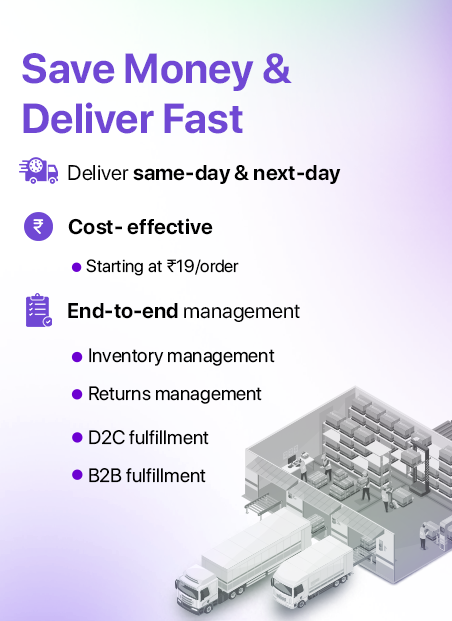- Introduction
- What is Obsolete Inventory?
- Why It Matters: Obsolete Inventory
- What Happens with Outdated Inventory?
- Advantages of Clearing Obsolete Inventory
- 5 Reasons that Cause Obsolete Inventory
- How to Get Rid of Obsolete Inventory?
- Preventing Outdated Inventory- 6 Ways
- 4 Ways to Stop Obsolete Inventory from Building Up
- Examples of Obsolete Inventory
- Say Goodbye to Obsolete Inventory with Shiprocket Fulfillment
- Conclusion
Introduction
One problem that all businesses face, regardless of the company size, with inventory management is the piling up of obsolete inventory. This could lead to the funds being wasted, taking up valuable warehouse space, and damaging the credibility of your business. This also badly affects the inventory turnover ratio, thereby hitting a business’ bottom line. The negative effects of outdated inventory and the consequences of inadequate inventory control can, in the worst case, lead to the bankruptcy of a company.

Here, we’ll explore the details of identifying, managing, and avoiding outdated inventory in this post to guide you through the crucial area of inventory control.
What is Obsolete Inventory?
Obsolete inventory, sometimes called “dead stock,” is inventory that a business considers no longer sellable or usable. It occurs when a product approaches the end of its productive lifespan, and there is minimal consumer demand, making it unlikely to find a buyer.
Certain industries, such as electronics, apparel, and furniture, are more likely to have outdated inventory. To prevent building up of products that no one would like to purchase, these companies need to be extremely careful about how they handle their inventory management system.
The nearing of the life cycle of an inventory is a gradual process. The slow movement of products in the market is typically the first sign that sales are going to go down. This might result in excess stock if left unaddressed. When it eventually becomes obvious that these products are out-of-date, they are categorised as obsolete inventory.
Why It Matters: Obsolete Inventory
Addressing the issue of obsolete inventory is important because of the terrible effects it can have on a business. Keeping track of outdated inventory is essential for companies. It’s a means of determining if a business is managing its production and marketing effectively. Outdated inventory can affect a business’s cash flow and possibly cause financial issues, especially for companies with thin profit margins. It may become a serious problem for a company’s long-term sustainability if left unchecked.
What Happens with Outdated Inventory?
Old inventory, often outdated, can pose a significant challenge for businesses. As time progresses, the value of these products decreases. This will force a company to sell them at reduced prices, potentially causing financial losses. Also, keeping this merchandise on hand for a long requires storage expenses, which reduces overall profitability. It also takes up valuable storage space and uses up the necessary funds. Certain products have expiry dates, which can cause them to become useless after a particular period.
Outdated inventory can lead consumers to doubt the reliability of a company, which could negatively impact the brand name. It could also have an effect on the financial records, which might further hurt the company’s profit margin. Businesses can encounter issues with outdated inventory as it takes warehouse space and uses resources that could have been allocated to more profitable products.
Advantages of Clearing Obsolete Inventory
Eliminating outdated inventory may benefit a business in a number of ways. This strategy helps to maintain better financial records and improves the company’s reputation with clients. Adopting these practices is essential for improved financial performance for startups. Let’s examine these advantages:
- Reduced Expenses: Removing out-of-date inventory results in savings on maintenance, storage, and other associated expenses.
- Improved Cash Flow: A company can free up cash by selling or deducting outdated assets. The savings can be utilised in other areas of the organisation.
- Time savings: When less effort is spent on maintaining obsolete inventory, more time can be allocated to profitable products.
- Improved Reputation: Maintaining a current inventory demonstrates a business’ dedication to providing high-quality items and nurtures a favourable image among customers.
- Simplified Finances: Companies can keep accurate and transparent financial records by writing off outdated stock. This makes it simpler to monitor the financial health of a business.
5 Reasons that Cause Obsolete Inventory
Here are 5 reasons that cause obsolete inventory:
- Technological Advancements
Rapid advances in technology have the potential to make a company’s current items outdated. As soon as more sophisticated and new alternatives come up, the value of the older inventory rapidly declines. Think of the switch from VHS to DVD and finally to streaming services. It demonstrates how the advancement of technology impacts inventory management.
- Changing Customer Preferences
Consumer preferences are subject to rapid changes. Items that were popular a while ago may become unappealing to them due to changes in fashion trends, demography, or lifestyle. It is imperative that a business be aware of market changes and modify its product offers to avoid having unsaleable inventory.
- New Competition
Due to the shifting dynamics of the market, new competitors could dilute a company’s current product lines. Their goods can be more appealing if they have more features, competitive pricing, or successful marketing techniques. Customers may move to more modern choices, making the products a firm currently has out of date.
- Government Regulations
Regulatory changes may significantly impact a product’s viability. Regulation changes can cause goods that were authorised to become non-compliant. It is important to adapt to changing laws and regulations in order to avoid obsolete inventory.
- Poor Demand Forecasting
Inaccurate forecasts of consumer demand may cause excessive production, which leaves a company with too much inventory that is out of date. For example, overproducing during a seasonal sale and not meeting the expected demand can result in unsellable inventory.
How to Get Rid of Obsolete Inventory?
It’s critical to get rid of obsolete inventory immediately once a company discovers it. Depending on the business objectives, the kind of inventory, and its worth, a firm can choose from a variety of solutions. The following are some methods for getting rid of out-of-date stock:
- Bundling Products: Put out-of-date products into a bundle of quickly-sold things to create fresh product ideas.
- Remarketing Items: Launch new marketing campaigns with new target markets to revive interest in out-of-date products.
- Offering a Discount: Selling outdated inventory at a discount could encourage customers to buy.
- Writing off old stock: This involves eliminating outdated inventory from financial records and categorising it as a loss. It’s typically done when inventory has no value remaining or sales prospects.
Preventing Outdated Inventory- 6 Ways
The following six strategies can be used by businesses to prevent obsolete inventory:
- Know What is Needed: Pay careful attention to the products offered, and base your inventory selections on previous sales and industry trends.
- Production Efficiency: Produce what you need when you need it. This reduces waste and improves flexibility.
- Make Regular Checks of Your Inventory: Examine what you have available. Set goals for the rate at which you wish to sell items, and utilise basic tools to identify goods that aren’t selling quickly.
- Keep Up With Trends: Keep an eye on what’s trending and what people enjoy. To keep up with the latest trends, engage with your sales and marketing staff and use social media.
- Effective Supplier Management: Maintain strong connections with your suppliers so you are able to obtain what you require.
- Clearance sales: Try to sell any outdated items you may have by giving them discounts. In this manner, you may recover a portion of your costs and free up funds for other purchases.
4 Ways to Stop Obsolete Inventory from Building Up
For companies to maintain revenue and efficiency in operation, it is critical to recognise the issue of obsolete inventory and put preventative measures in place to prevent its build-up:
- Liquidation
Consider the practical liquidation approach to get rid of your obsolete inventory. You may recover some cash and free up storage space by selling your inventory to third-party purchasers at a discount.
- Rebrand
You can also consider rebranding as an option. Reviving interest in the product and increasing sales could be possible if you redesign its image and target a different market.
- Recycling
If you have recyclables in your outdated inventory, you must dispose of them responsibly. To reduce waste and the environmental impact, sell these products to recycling centres.
- Repurposing
Consider putting some of your obsolete items into new applications. Use these things in creative ways, such as as accessories or replacement components for other products.
- Donation
Donating your outdated inventory to charities has two benefits. It could also offer tax advantages and improve the general impression of your company. Donation is appealing to customers who value social responsibility.
Examples of Obsolete Inventory
Here are a few of the examples of obsolete inventory:
- Outdated components
- Excess inventory from discontinued products
- Unsellable dead stock due to changing customer preferences
- Technological upgrades have made older product versions obsolete
- Expired goods
- Machinery components that are no longer in use or supported
- Last season’s fashion or accessories that have limited sales potential
Say Goodbye to Obsolete Inventory with Shiprocket Fulfillment
For retail and eCommerce companies, Shiprocket Fulfillment offers an all-in-one platform that streamlines B2B and B2C operations. Efficient inventory control, shipment fulfillment, and performance assessment are made possible by the network of fulfillment centres conveniently situated across the nation. With the help of Shiprocket Fulfillment, businesses can achieve centralised order management and total visibility by integrating different sales channels. Additionally, sellers can also benefit from same-day or next-day delivery services. Shiprocket Fulfillment is committed to lowering shipping and delivery times, guaranteeing effective order management to avoid the accumulation of obsolete inventory. This eventually enhances the seller’s relationship with customers.
Conclusion
Although dealing with obsolete inventory might seem challenging to a company, it can be efficiently done with the right tools. Observe carefully what you buy, keep up with industry developments, and cultivate a strong relationship with your suppliers. Recall that this is critical for both the financial stability and client satisfaction of your company, as well as for reducing expenses. Keep your inventory management strategies current so that obsolete items do not halt your development and success. In this ever-changing marketplace, a company’s greatest asset will be its capacity to adapt and overcome.
Monitoring product sales and market movements attentively is necessary to spot outdated inventories early. Indicators include a sharp decline in sales or shifting consumer preferences. Becoming outdated can be identified by routinely evaluating your inventory and establishing specific objectives for selling slow-moving products.
Due to the rapid pace at which technology and consumer preferences evolve, some industries, such as electronics, fashion, and furniture, are more likely to accumulate outdated inventory.
Apple is one business that has done an excellent job of controlling its old inventory. They have a history of launching buyback schemes for outdated electronics, enticing consumers to exchange their old goods for savings on more recent items. By using this tactic, Apple retained its client base and eliminated outdated inventories. Many other companies have also employed clearance discounts and repurposing tactics to stop the build-up of obsolete inventory.





